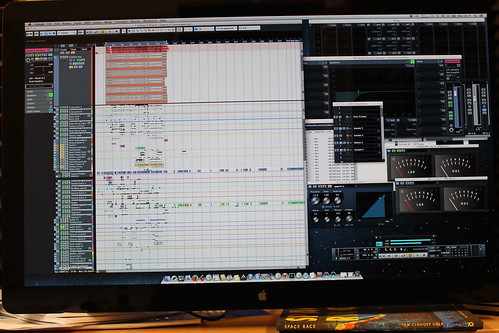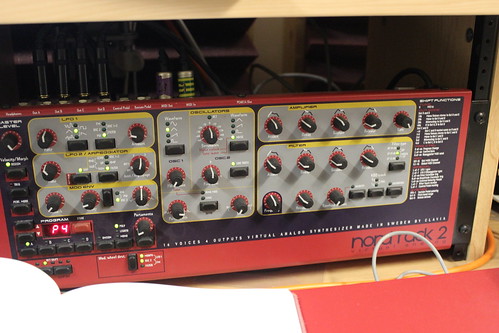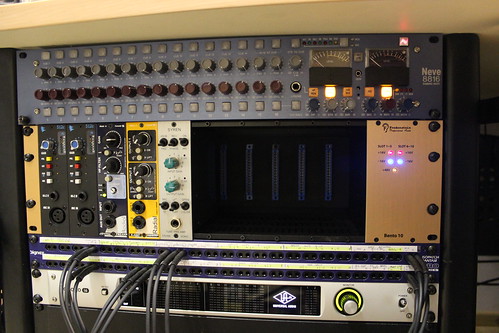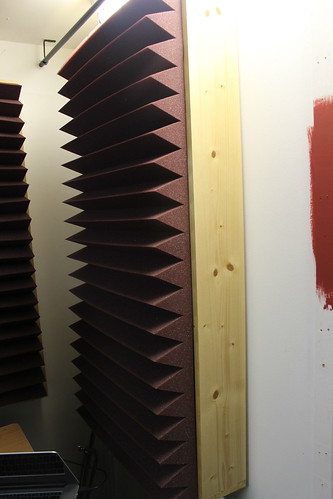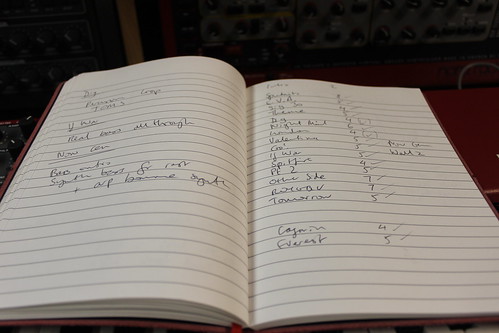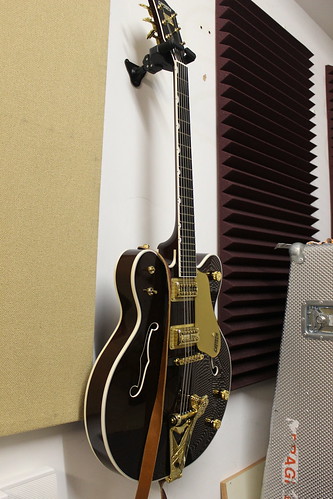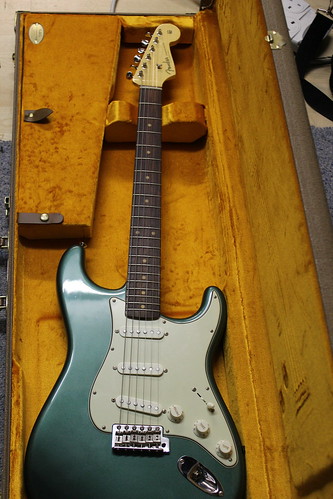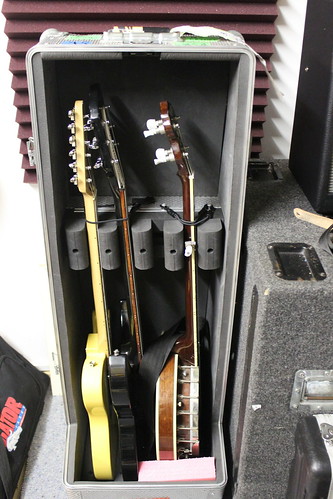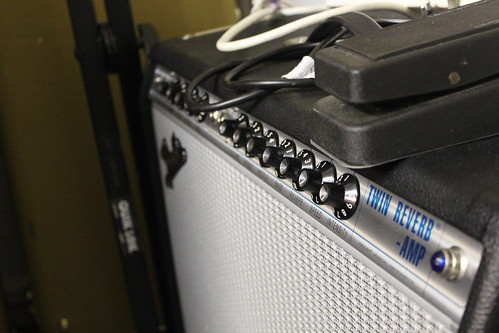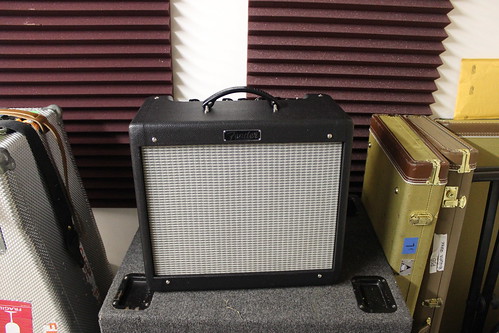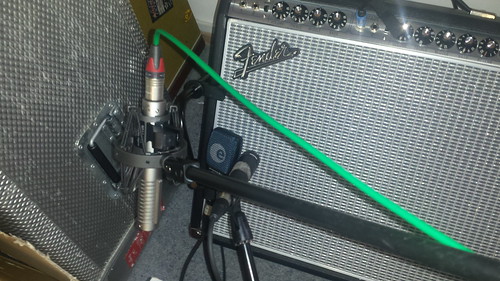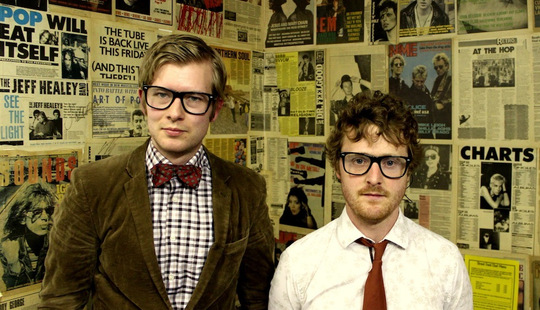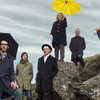Public Service Broadcasting's new album The Race For Space will be released on the 23rd February 2015. The band will be using exclusive archive footage from the BFI retelling the story of the American & Soviet Space Race from 1957-1972, J. Willgoose, Esq of Public Service Broadcasting talks us through it all...
Studio
This is my studio. I haven’t tidied it up (sorry Mum) because I thought it was important to capture the ‘creative mess’ I like to operate in. That, plus I’m very lazy on that front. Notice the paint sampler on the wall – further evidence. Even though I quite liked the colour, that was as far as I got, because more important things needed doing first.
My studio is in the back end of a converted garage in south-east London and is, I would say, a relatively modest but functional one. I am very lucky to have it so close to home (my commute is very short on the days that I’m working on new material), even if it is very warm in the summer and very cold in the winter (note optional cardigan on chair – very stylish).
It’s based, workflow-wise, around a Macbook Pro connected to a Thunderbolt display, and a Universal Apollo 16 soundcard feeding everything in and out. For anything that needs a decent room sound – drums, brass, strings and so forth – we go to a ‘proper’ studio and track it there, but everything else is done here, including the mixing.
This is what I look at most days – I’m still working on an older version of Cubase, Cubase 5. I had meant to take up a new DAW for writing and recording the new album but there just wasn’t time, sadly – I wanted to avoid falling back on the same techniques and tricks by learning something new, but had to knock that on the head in January when I realised I basically had a month and a half to write our second album. As I’ve said since then, this new album is basically the first one but with a bit more reverb – you know, to make it sound all space-y and that.
Synths
These two synths are the bedrock of the synthetic sounds on the new record. In the background is the very powerful and versatile Access Virus TI 2 – it’s great for a whole range of sounds, even if I don’t quite trust the USB integration and try to do most stuff via MIDI instead. I only bought this synth (second-hand, like a lot of my stuff) in July, as previously I was using the Virus Snow, a far more portable but stripped-down version which I also use live. Having the TI2 means I can separate touring / recording gear out a bit and save a few transport-based headaches, which always helps.
Immediately in front of it is a Nord Lead 4. I bought that in January right at the start of the writing of this album and I love it. It’s smoother-sounding than the Virus – I’d describe it as a purer subtractive synthesizer, and it certainly doesn’t have as many EQ / effects / modulation possibilities as the Virus, but between the two of these I’m pretty much covered. I’d love to add a proper analogue synth to the setup one day, space permitting (which, as you’ll have seen, is limited), but I’m slightly wary of maintenance issues. These two have served me very well, anyway, and the Nord Lead should be coming out on the road with us next year.
I bought the Nord Lead 4 as a semi-replacement for my old Nord Rack 2, bought (second-hand!) and seen below.
It’s a great little synth and has served me very well through the first EP and album, but I started to get a bit frustrated with some of its limitations, hence bringing in its younger brother. It still features on some of the album tracks though, especially on ‘Sputnik’.
Patchbays
All of this analogue stuff goes in and out of the patchbay, second from the bottom. Patchbays don’t get a whole lot of love in the ‘gear’ world – they’re just not that exciting, I suppose – but I can’t tell you what a difference having this little unit has made to being able to work quickly and flexibly. It was definitely, definitely worth the money. It sits immediately above the Apollo 16, which is a great soundcard and has the added bonus of allowing me to use a lot of UAD plugins. A lot of the sound of this album comes from the Ampex tape simulator, the Maag EQ plugin, Neve, SSL & API channel strips and the EMT & Lexicon reverbs, plus the Fairchild compressor / limiter emulations. I tend to try and use as few tools as possible to get the job done as I find it helps me work more quickly – these plugins have been an absolute god-send though, they’re amazing to use and sound fantastic. I’m also a big fan of PSP Audioware plugins – they’re a very small company based in Poland but they make some great stuff that really stacks up against some of the bigger boys.
Bento 10
Directly above the patchbay is a Fredenstein Bento 10 – the cheapest (yet still decent-quality) series 500 bay I could find. You’ll notice there are 6 empty slots, which is very worrying for my bank account as they’re just begging to be filled, but anyway, from left to right I have two API 512c preamps; a Radial JDV-Pre unit for all guitar / bass DI-ing; a Radial re-amper, which is fantastic when you’re working on your own in a studio as it gives you more options and more time to divide the work (I can focus on playing something well and then worry about getting it to sound good later); and then the newest addition, a Crane Song Syren tube pre-amp. I got that B-stock – in fact if it’s not second-hand, you can guarantee most of my stuff is B-stock! – and it sounds absolutely fantastic on the Royer R121 ribbon mic I also bought for recording guitars.
Neve 881
Sitting atop the lot, like the king of sound equipment that it is, is the Neve 8816 summing mixer. I have to admit to a lot of scepticism about summing mixers, analogue sound in general and people moaning about digital recordings; then I bought this (B-stock, wahey!) and had to eat my words. Just routing stems out of the UAD card and then back into the computer, I can’t describe it, but it just makes things sound better. I think of all the equipment I acquired in the making of the new album, this is the one that made the biggest difference. Still slightly annoyed that I couldn’t screw it into the rack properly, mind.
Monitors
Monitoring is courtesy of these Adam A7s. I bought them – wait for it – as B-stock about 4 years ago now and I really know the sound very well. There’s not much below 100Hz, so you have to be a bit careful, but overall they sound great and they’re not too tiring on the ears either. If you look closely you’ll notice a different dB scale on either speaker – I’m not even 100% sure they’re the same model, and I had to put a phase-reverse adapter on the back of one of them (!) – but it works. No, really, it does work, honest! If I ever have enough money though I’d love to upgrade to a pair of the Adam S3X-Hs. They sound absolutely brilliant.
Something else which doesn’t tend to get a lot of love in the studio world is acoustic treatment. I built these traps with my dad several years ago – I’ve got 7 of them dotted around the studio along with a few other odds and sods I’ve managed to salvage over the years – and while they’re a bit rough around the edges they do a great job. It’s Auralex foam sat on top of 10mm Rockwool, with a gap at the back. They’re from an old issue of Sound on Sound – have a look here if you’re interested. http://www.soundonsound.com/sos/jul06/articles/studiosos_0706.htm
Oh – and while we’re busy being boring, here’s another vital piece of studio equipment – a notebook. As Stanley Kubrick once said, ‘I don’t trust people who don’t write things down. Many people feel it’s beneath their dignity to take notes, and try instead to trust their memories. I don’t work with them.’ My note-taking on the last album was awful and it really slowed me down when it came to editing; this time, I resolved to do things better and I’m very glad I did.
Right, let’s get back to some exciting stuff, and my one true Achilles heel.. namely guitars…!
Guitars
This is my most recent purchase – a beautiful, beautiful Gretsch Country Gentleman, designed & played by Chet Atkins (not this one, though, don’t worry!). I play a reasonable amount with my fingers and also wanted a big hollow-body sound for this album in a couple of places – the Rickenbacker 330 which is my standard guitar just wasn’t quite cutting it. I can’t describe the feeling playing this guitar gives me, but as soon as I picked it up and played my first few notes on it, I knew it was the right guitar for me. It also encourages you to play in a different way, which is immensely helpful when it comes to writing new songs. I’d say for every new synth or guitar I buy (and I try to behave myself!) I get at least 2-3 new ideas from them.
Another recent purchase is this American Vintage ’59 Strat. I’ve always, always been a Fender man rather than a Gibson one – if they’re good enough for Sonic Youth then they’re good enough for the likes of me – and even though I wasn’t that keen on Strats, I knew I needed one for ‘Gagarin’ as soon as I wrote it. What really surprised me once I bought this guitar was just how versatile it is, and how much I really, really love playing it. I was lucky enough to get an Artist Endorsement from Fender last year and since then I’ve basically been after any excuse to buy their guitars – just as long as the Mrs is ok with it (she’s normally pretty good, to be fair) – but again, just as with the Neve summing mixer I had to throw away my preconceptions once I actually sat down with this guitar and started playing it. It’s a knockout and an absolute joy. Next on my list is a thinline Tele and a Jazzmaster… again, bank balance beware! I think I’ll wait a couple of years for those…
While we’re on the subject of guitars, here’s my touring case, a Triple Row from Scott Dixon. It’s been on many, many flights and paid for itself numerous times over by now – being able to take two guitars (an American Vintage ’52 Telecaster and the aforementioned Rickenbacker 330, in this case) and the banjo in one bag rather than three really saves money, plus it’s great protection for them. It also gets a lot of enquiring, admiring glances at festivals – this case is definitely a conversation starter (in certain, very sad, circles, anyway).
Live Rack
While we’re on the subject of touring, here’s the front of my live rack (I’m not showing you the back, it’s too hideous for words). From the top, it’s 2 power units, a MOTU Midixpress (the cheaper version!), a TC Electronic d2, a MOTU 828mk3 for spare purposes, an RME Fireface 800 which is what gets used live unless it breaks (if in doubt, buy German!), a Korg tuner, then a JoeCo Black Box Recorder / Player which is our backup-backup system. Having technical issues live is the stuff of nightmares so I like to be well-prepared.. with this setup, fingers crossed, we haven’t had any total disasters.. yet! At the bottom is a Sennheiser wireless IEM transmitter for in-ear monitors.
Amps
Back to recording, and for this album I wanted to get some real amps on there – everything up until now, every single guitar sound, has been done via software amping – and where better to go than a Fender Twin. This is an absolute beast. It weighs a ton, sounds like it could blow the roof off if it felt like it (sorry, neighbours) and has that beautiful spring reverb sitting in the back, too. For more overdriven tones I also got hold of a Blues Junior amp (pictured below), which is a great little amp and might come out on the road with me next year.
I mic’d these amps with a combination of a trusty SM57, a Sennheiser 906 (the flat one) and the Royer 121. You simply can’t go wrong with a combination like that, although you do have to be careful with phase issues.
Well – I think that’s pretty much it, except for a vital final inclusion… every studio needs a mascot, and here’s mine, Pablo the Panda, peeping out from behind a spare soundcard. If your studio sounds terrible, you can’t get the sound you want or you’re having technical difficulties – look no further. This little guy will sort you right out.
Stream The Race for Space in full now:
Browse our Planet Gear archive for more studios and equipment and that sort of thing.



